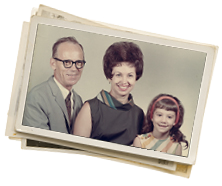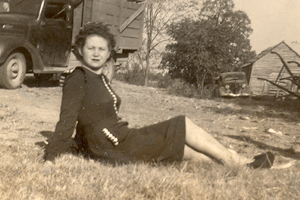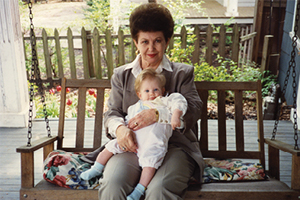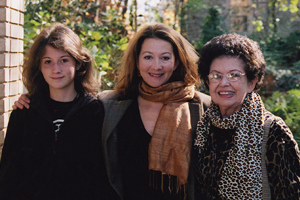Letting Mom Go
By Rhonda Mullen

Wynette Elizabeth Mullen Allen (February 22, 1925 - April 12, 2012)
|
My mom was the quintessential steel magnolia.A Depression-era child who grew up in hardscrabble Northern Mississippi, she worked all her life—on the farm, in a hosiery mill, later still in a shipyard on the coast. I thought her tenacity would see her through this stroke as it had two previous strokes. |
My mom died a few days after Easter a year ago. After a day of labored breathing, she finally was sleeping peacefully when I left for the night. The nurses had drawn a white blanket around her shoulders, her hair was newly washed, and the tubes so often present at the end of life were mostly gone.
I hadn't been home long when the phone rang. It was from one of the many gentle nurses whose names I no longer remember, but I remember what she said. "I am so sorry, but as I walked in to check on your mom, she was taking her last breath."
The finality of death always takes us by surprise. My mom was the quintessential steel magnolia. A Depression-era child who grew up in hardscrabble Northern Mississippi, she worked all her life—on the farm, in a hosiery mill, later still in a shipyard on the coast. I thought her tenacity would see her through this stroke as it had two previous strokes—at least for many more days, even weeks, months.
"What should I do?" I asked the nurse. "Should I come back? Who should I call?" That's the weird thing about moments of crisis. It's hard to make the simplest decisions. All my education and experience had fled. There I was, as I had been since Easter morning, in a state that left me wondering what was the right thing to do.
I was lucky because at Emory, I got answers, help, and support from people who appeared when I needed them most: doctors, nurses, palliative care specialists, students. I learned that sometimes there is no right thing to do, that you do the best you can.
At Emory, Mom was lucky too. All of Emory's hospitals are certified by the Joint Commission as advanced primary stroke centers, which means that they follow best practices in stroke care. In other words, Mom got the best stroke care available.
Outside that Easter Sunday morning, the sky was sunny, a spring nip was in the air, daffodils were blooming. Inside the emergency department at Emory University Hospital (EUH), the neurologist showed me a white area that filled Mom's MRI and showed the massive blockage in her brain. She sat with me and explained what this meant. It would impact areas that controlled speech and movement. The clot-busting drug, tPa, wouldn't work because the window for its effectiveness had passed. Instead of dissolving the clot, the drug now might cause my mother to bleed out. Instead the stroke team proposed to closely follow her over the next 24 hours to see if any of the damage would recede on its own and how much function could be regained.
|
|
Wait and see
The nurses took us in hand in the neurology step-down ICU. They installed Mom in her room, took her vitals, scheduled the next tests. They showed me the essentials—bathrooms, a refrigerator for family use, the cafeteria downstairs. They put their first names on the board in the room as they came and went. When a nurse named Rosa arrived for the night shift, I felt that everything was going to be all right—as much as the circumstances allowed. She talked to Mom, explained what was happening, squeezed her hand. I know enough about hospitals to know that Rosa does this with new patients on every shift, but that night, we felt like we were her first and only concerns.
A medical student came in the early morning to do a stroke assessment. In Emory's medical school curriculum, students no longer wait until their third year to interact with patients. They work on clinical services from Day 1. This young man was close to the age of my oldest daughter, my mother's first grandchild, and he had never done a stroke assessment before. I could tell that he was nervous, but he had a list of steps, and he went through them.
"How does it look?" I asked when he finished. He was honest: "I'm not sure I did it right." But he walked me through what signs he was measuring, the scores he recorded. Both this young man and I would learn more later in the day.
The resident came next, then the chief resident, then midday, the chief of service. Aaron Anderson was a familiar face. He had evaluted Mom soon after she moved here from her beloved home in Mississippi. To say that she had been less than happy about relocating would be a dramatic understatement. But after a series of falls—broken ankle, wrist, two fractures in her back—and several smaller strokes, she needed to be near me so that I could see to her basic needs and near a tertiary care hospital to have access to better health care. Anderson won her over not so much for his education, training, and experience but because his wife was—you guessed it—from Mississippi. He reminded her of home.
The news he brought after evaluating the tests and examining Mom was not good. She would not walk or talk again. It would remain difficult for her to swallow. She was left only with the use of her left arm. He asked if I wanted a palliative care consult. Yes, I did.
|
|
Comfort care
The term palliative care may be unfamiliar to some, but I knew about the specialty after editing an article on palliative care for this magazine. Many people confuse palliative care with hospice because both approaches emphasize the management of symptoms rather than attempting to cure the disease itself. Palliative care sees to the physical, emotional, and spiritual comfort of the patient and their family. But unlike patients in hospice, those in palliative care may continue to receive traditional, curative treatment and eventually recover.
"We are called in when it's not so clear what the options are," says nurse practitioner Shella Chawda, who is on Emory's palliative care team at EUH. "We help in understanding the big picture." She does a lot of listening on the job, encouraging patients to talk about what they expect from quality of life, what they understand about their health and prognosis. The process is guided by the family, what they need, what they want, and every day Chawda tries to meet the patient and family where they are.
Emory's palliative care team is growing. The service currently includes two physicians, five nurse practitioners, two chaplains, and an RN who cover EUH and EUH Midtown.
The Nell Hodgson Woodruff School of Nursing is taking palliative care at Emory even further with support from a $1.5 million training research grant from the U.S. Department of Health & Human Services. Led by Carolyn Clevenger in nursing and Tammie Quest, Roxanne Arnold Professor of Palliative Medicine, the grant trains primary care teams to incorporate palliative care practices in general patient care. Over the next three years, training will take place with teams in six units that treat patients with life-threatening illnesses: leukemia, heart failure, hospital medicine (frail elders, those with cystic fibrosis), as well as medical, neurological, and surgical critical care. The teams are customizing the palliative care model for their areas, making modifications in the timeline and steps that work for their patients. As the program unfolds, the researchers will evaluate what is working and what isn't, track improvements in outcomes and quality, and share results so that others can learn from their model.
In talking with Chawda, I shared conversations that Mom and I had had about her wishes for end of life. I told her that I was Mom's power of attorney for health care, that given the prognosis, I didn't want to prolong her life. Even talking to a nurse practitioner as patient, knowledgeable, and concerned as Chawda, it was difficult for me to express those wishes aloud. I didn't want to take my mom's life, but I didn't want her to suffer. Within power of attorney is the word power, and I wanted to use it carefully, wisely.
Chawda explained to me that Mom's caregivers could withhold the heart medication that the medical team had hoped would calm a heart arrhythmia that had contributed to the stroke. But she suggested that they continue the high blood pressure medicine: withdrawing that might lead to headaches and pain. She asked if I would like to speak to a chaplain, but my own minister and friend was sitting with Mom in her room even as we spoke. She asked if I wanted to consider hospice, given the severity of the situation. Again, yes, I did.
|
|
The last goodnight
Vista Care Hospice on the fifth floor of EUH is a quiet place with soothing colors, reclining chairs, and a separate lounge where families can read the newspaper, watch television, microwave a meal, check email, or stare out the window at the world going on as if it were a regular day. It sits only three floors above the neurology step-down unit, but the beeping monitors and hustle and busy-ness of an active medical floor are gone here.
As I walked through the doors of the hospice the second night after Mom's stroke, a hospice nurse met me with a big hug. All the steel magnolia that I had inherited from my mother flowed out of me and into the open arms of this strong woman. "It's okay, baby," she said. "It's okay. Now it's in God's hands."
Mom and I had come to the last leg of our journey. Other people on the floor had big families, and over the next few days, I could hear them coming and going, crying and laughing, all grappling in their way with the end of a loved ones' life. But our family is small—just me (an only child and adoped at that), my two daughters, a few dear friends, and out of town, a handful of cousins and one uncle in his 90s.
I sat with Mom and talked to her. I asked her if she was going to be happy to see her mom, her sisters, her brother, Daddy, her second husband Bill. I asked her how it would work with two husbands in heaven. If she heard me, she appreciated the irreverent humor. I thanked her for the music and art lessons, the college education, for loving me when I wrecked the car, when I left the marriage.
My pastor brought a simple flower bouquet picked from her garden. My cousin in Kentucky called, and I held the phone up to Mom's ear while she talked. (She had a lot to say.) I started getting together thoughts for the funeral service back in Mississippi: favorite verses of scripture, music. "I come to the garden alone" was the hymn that Mom used to sing every Saturday morning while she cleaned house, but she never got past the end of the first line "while the dew is still on the roses" before she'd rewind the song, over and over, until the vacuuming was done.
My oldest daughter, Charlotte, stopped by after her art history class at Emory. My best friend of the last 40 years arrived in comfortable shoes and clothes, with a laptop and magazines, prepared to spend the day. True southerners, we ended up sitting in a semicircle by mom's bed and talking. We told stories of Sissy, as Mom was known to all her family. Charlotte practiced her honor's thesis that she had to present the next morning. She mentioned a boy she had met who she hoped would call.
Wynette Elizabeth "Sissy" Mullen Allen died later that night.
We can't always get our wishes or plan how we'd like to exit this life. Too many of us end up spending more on health care, often futile, in the last month of life than over the rest of our years combined. But Medicare fully covered the cost of Mom's hospice care. More than anything, I am grateful that my mother had a quiet and dignified death with the stories of the ongoing lives of those she loved still ringing in her ears. EH
Editor's note:I wrote this memory on February 22, what would have been Mom's 88th birthday. If she was still here, she would remind me to thank the security guard in the Emory emergency department who had a kind word for a daughter who was scared and alone. And she'd say to give those Emory doctors, nurses, and staff who shared their skills and care, kindness and concern a big Mississippi hug. |
Related Links
"Emory University Hospital earns advanced certification for Comprehensive Stroke Center"










